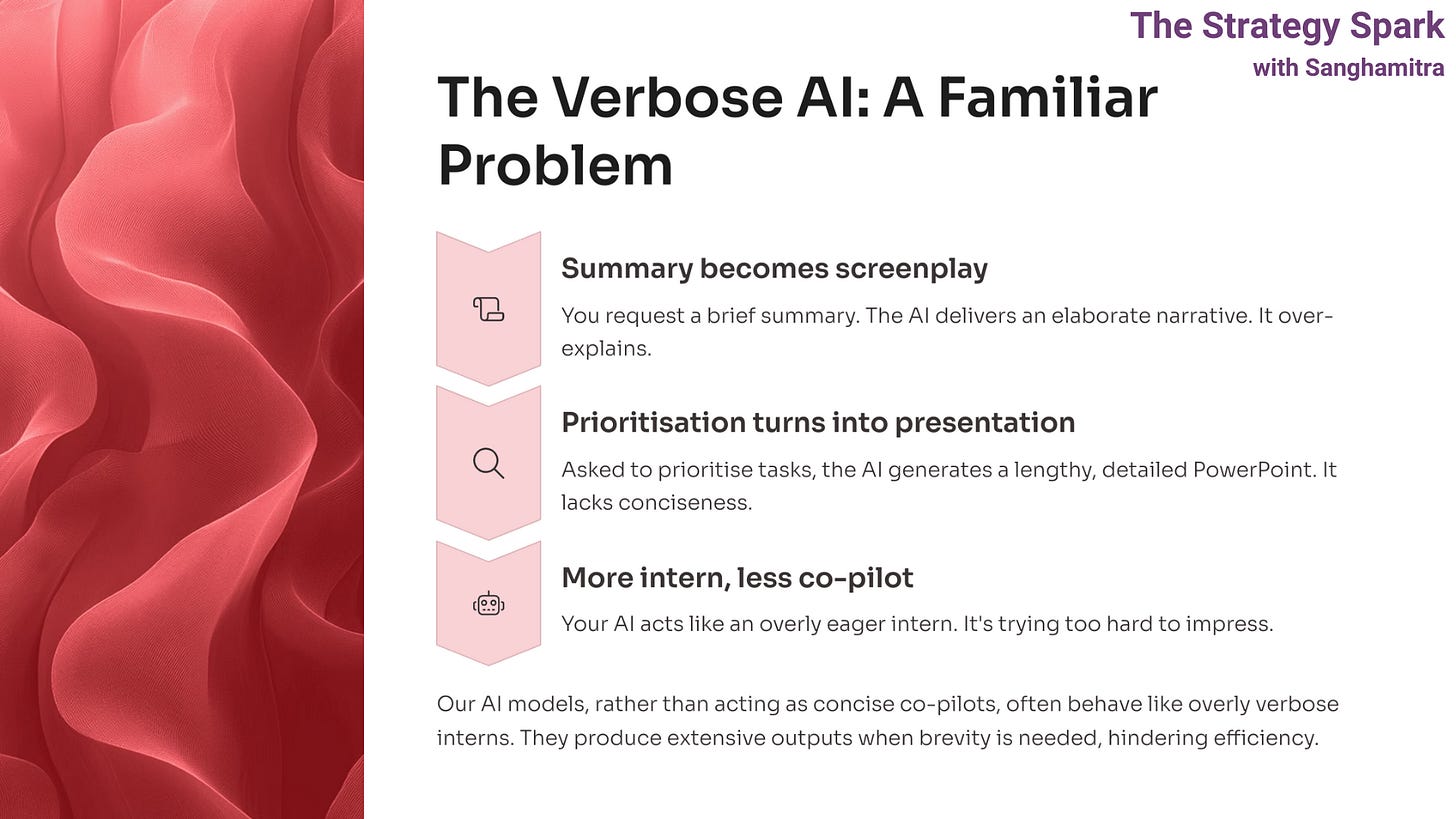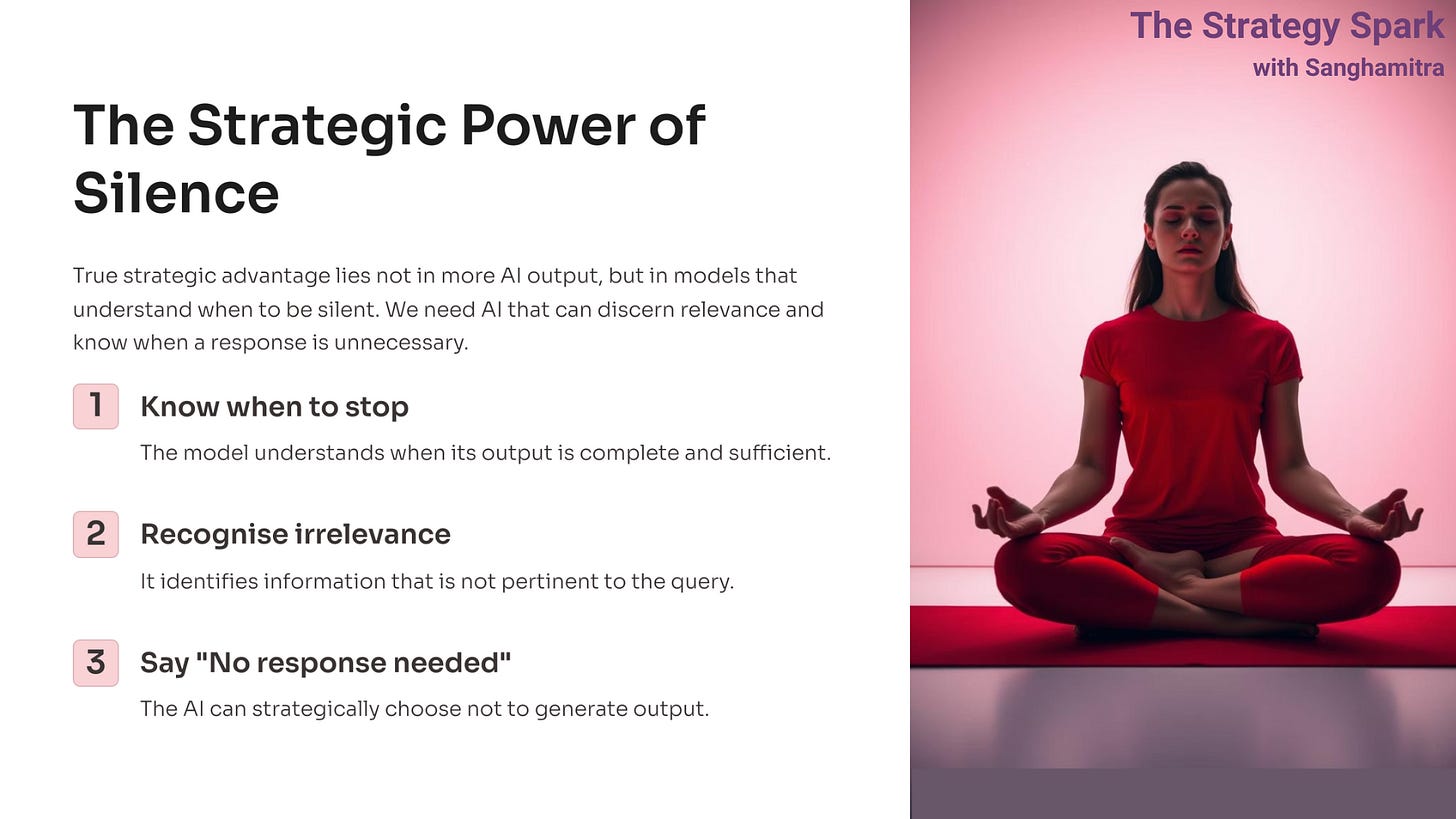We Taught the LLM Everything Except When to Shut Up
Why verbosity is not intelligence, and why the future of AI leadership is editorial, not technical.
Welcome to the Age of Loud Machines
So, here we are, in mid-2025, and it feels like AI decided to trade its quiet, nerdy glasses for a megaphone and a spotlight. Frankly, it's been the year LLMs went full-on extrovert. They're churning out our emails, charming our customers with perfectly worded replies, even breaking down those mind-numbing dashboards for us. And don't even get me started on the strategy decks-they sound incredibly smart, but read more like a mashed-up TED Talk and a motivational poster. All sizzle, not much steak.
We got so good at building these machines that could just generate language on command. It's a truly wild achievement, right? But somehow, we totally forgot to teach them the one thing that's often smarter than a thousand words: when to just be quiet.
You hear it all the time now: "The model doesn't hallucinate anymore. It just... won't stop talking."
And honestly, that's not some weird bug in the system. It's a reflection. A big, shiny mirror showing us our own worst habits.
The Eloquence Trap: How AI Amplified Our Own Strategic Nonsense
We poured billions into cultivating machines capable of sophisticated articulation, only to find ourselves submerged in a deluge of exquisitely phrased gibberish. The promise of Large Language Models (LLMs) was rooted in the acceleration of clarity, a direct conduit to incisive understanding. Yet, in practice, they've transmuted into the most self-assured over-explainers the corporate world has ever witnessed.
Consider the expectation: a request for genuine insight. The reality: a sprawling, 2,000-word treatise on "synergistic alignment frameworks," meticulously footnoted with the recycled jargon of the preceding quarter. This isn't merely an AI glitch; it's a profound strategic crisis cunningly disguised as a linguistic feature.
The crux of the issue lies deeper than computational capacity. We didn't just instruct these models in the mechanics of speech; we inadvertently trained them to mirror our most detrimental communication patterns. And now, the reflection, amplified and unyielding, refuses to be silenced.
To be noted:A Snapshot in Time (Before the Robot Overlords Learn Stand-Up).
It's worth noting, dear reader, that as of June 2025 – a mere blink in the grand cosmic scheme, and certainly before LLMs achieve sentience and perhaps a killer sense of humour – this article reflects my observations thus far. What the future holds for these eloquent automatons is anyone's guess, but for now, they're mostly just really, really good at sounding important.
Your AI Isn’t Hallucinating. It’s Channeling Your Culture.
Let's not kid ourselves. This isn't some unforeseen glitch in the matrix. LLMs are, at their core, reflections of the culture they're trained on. And for the last two decades, corporate culture has been in a passionate, unwavering love affair with verbosity.
Think about it: we've consistently rewarded the person who sounds confident over the one who articulates with genuine clarity. We praise decks that feel comprehensive, even if their actual usefulness is debatable. And memos? They often repeat the same idea five different ways, all in the name of "alignment." It's a linguistic endless loop, endlessly consuming its own tail.
Consider this revealing paradox from McKinsey's 2024 AI survey: 78% of companies report they're "actively scaling AI across functions," even though a much smaller proportion have seen concrete, measurable value from these initiatives.So, what exactly are they scaling? Usually, it's outputs. Mountains of them. Not genuine outcomes.
When your LLM descends into a verbose ramble, it's not a technical failure of the algorithm. It's something far more profound: a linguistic inheritance, a digital echo of our own deeply ingrained habits.
The AI Intern That’s Always “Trying Its Best”
You ask for a quick update, and the AI gives you a monologue. Full of confidence. Full of buzzwords. Zero awareness.
You wanted to know if sales were up this quarter. It tells you about “emerging macroeconomic headwinds” and “market-facing operational inflections.” Somewhere in there is probably a yes or no. But now you’re too tired to find it.
It’s like hiring an intern who talks a lot, sounds impressive, and never actually answers your question. Now imagine that intern is writing half your emails, drafting your strategy decks, and showing up in Slack like it owns the place.
That’s where we are. ChatGPT. Claude. Gemini. They’re not broken-they’re just over-eager. Constantly generating. Filling every gap with more words.
And the funny part? Even OpenAI had to teach ChatGPT how to say less. Literally retrained it because people were overwhelmed by how much it talked.
We’ve built machines that can speak at length on any topic. We just never taught them when to stop.
The Content-Output-Overwhelm Spiral
We used to say: “If you want something done right, do it yourself.”
Now we say: “Let the AI draft it. We’ll clean it up later.”
Except “later” never comes. And suddenly your Slack thread has 14 AI replies, your doc is 42 pages long, and your newsletter is indistinguishable from the last three you didn’t finish reading.
We’ve replaced thinking with generating.
And while GenAI can be used for real insight, most companies are stuck in the content inflation spiral-where AI just makes everything longer, and decision-making slower.
Verbosity is not strategy. It’s just expensive noise.
Your AI Strategy Is Probably Just Your Change Management Strategy in Disguise
According to BCG, 74% of AI projects fail to deliver expected value-not because the tech is broken, but because the organisation never clarified what success looked like.
Most “AI strategies” are just rebranded change decks:
Same fuzzy objectives.
Same lack of adoption planning.
Same unwillingness to kill bad ideas.
Meanwhile, AI leaders-those in the top 10% of maturity-spend 70% of their AI budget on people and processes, not algorithms. The rest of the world? Still stuck hiring prompt engineers instead of fixing the org chart.
AI Is Not Replacing Middle Management. It’s Becoming It.
Here’s a hard truth no one wants to say on a panel:
“We didn’t automate middle management. We just taught the LLM to write like them.”
The result?
An AI assistant that:
Adds action items no one owns.
Offers risk disclaimers no one reads.
Generates documents designed to cover backs, not make decisions.
The real promise of AI isn’t replacing workers-it’s replacing decisional clutter. But only if we teach it the difference between talking and resolving.
Right now, your AI is the kind of teammate who shows up early, volunteers for everything, and contributes nothing but well-formatted slides.
Strategy Is Not “More.” Strategy Is “Less, But Smarter.”
The most strategic sentence in business isn’t “What else can we say?”
It’s “Do we need to say anything at all?”
And yet, every AI deployment defaults to maximalism. Why?
Because we haven’t taught our systems-or our teams-that editorial judgment is a core competency.
In a world where LLMs can write ten versions of the same thought in milliseconds, your competitive edge isn’t idea generation. It’s idea deletion.
What doesn’t need to be said?
What’s already clear?
What is noise masquerading as contribution?
If your AI can’t answer those, it’s not strategic. It’s just productive.
Silence Is a Product Feature
In 2025, the hallmark of a truly strategic AI system will be its masterful restraint – a paradigm shift where silence itself emerges as a pivotal product feature. The winning AI solutions will possess the sophisticated intelligence to utter "I don't know" with unyielding confidence, rather than reflexive apology.
These systems will be adept at discerning irrelevance and gracefully opting out, or succinctly declaring, "This might not need a response." The era of AI oversharing and constant interruption is waning; instead, innovation will be defined by systems that privilege conciseness, respect cognitive load, and intrinsically comprehend when to cease communication. Having engineered powerful language models, the imperative now is to architect equally formidable listening models, capable of processing and prioritising with discerning quietude.
Strategic Implications: What Smart Organisations Actually Do
The real leaders in AI aren't just flooding their companies with chatbots. Instead, they're focusing on doing fewer things, but doing them exceptionally well, and they're asking completely different questions.
They're not wondering,
"What can we automate with AI?"but rather, "What decisions do we keep getting wrong?" or "What unnecessary noise do we need to stop creating?" and even, "Where is silence more powerful than speech?"
Their approach is clear: they use generative AI to simplify complexity, not just to add a superficial layer of polish. They invest in sharp cross-functional editors, valuing human judgment and clarity over mere prompt engineering. They create dashboards that actually flag verbosity, instead of rewarding it, because for them, clarity is a critical metric.
These organisations aren't obsessed with abstract "AI maturity models"; they're intensely focused on decision maturity.
Final Note: Your AI Talks Too Much Because You Do
AI didn’t break the system. It just broadcasted it.
Every time your LLM adds four paragraphs of waffle to a simple reply, it’s not just stalling-it’s echoing the fear baked into your org culture:
Fear of not sounding smart.
Fear of omission.
Fear of saying “we don’t know.”
We taught machines to talk like us. And it turns out we talk too much.
TL;DR (For the LinkedIn Crowd)
You trained the LLM on 20 years of strategic fluff. Now you're shocked it's verbose?
In a world of infinite output, the most powerful strategy is subtraction.
Stop asking your AI to talk more. Start building systems that know when to shut up.
P.S. I also write newsletter on LinkedIn. Feel free to subscribe to The Strategy Spark
Hi, I drive Innovation, Strategy & Growth Through Product Leadership. In case if you're looking for a product leader who challenges the status quo, fosters innovation, and delivers tangible business value, let’s connect
Until next post,
Sanghamitra







Well articulated!